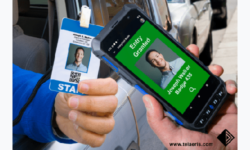Biometric Authentication: The Key to a Secure Digital Future
Customers have to remember more than 14 passwords on average, and complain about the inefficiency and complexity of authentication.

Photo courtesy of Veridas
An ever-expanding digital space demands managing a growing trove of passwords, continuously leading to a burdened user experience.
According to research from McKinsey, customers have to remember more than 14 passwords on average, and increasingly complain about the inefficiency and complexity of the authentication experience. Clearly, the era of conventional passwords is ending, making room for the advent of biometrics, where users have the choice to either use their face or voice to access services.
While we are witnessing a growing demand for biometrics technology, the journey toward comprehensive, holistic acceptance of this approach remains gradual.
When it comes to executing this new process, the change from passwords to biometrics can be accomplished quickly and easily; the difficulty lies in getting people and organizations to make the transition.
This is where those closest to the solution, such as dealers and integrators, become critical in shifting the narrative.
The Transition From Passwords to Facial Access
Password security systems have been relied on as the cornerstone of digital identity protection, leading many to assume they were a reliable safeguard. However, this perception contrasts with the reality faced by IT professionals, as a recent LastPass study revealed that 95% of experts view passwords as a substantial security risk to their organizations.
This is a huge determining factor for those responsible for purchasing the best solutions to keep their company safe.
The burden of managing numerous passwords across different platforms often leads users to unsafe practices, such as reusing passwords, which increases risk exposure for organizations. This scenario presents a unique opportunity for security professionals. By understanding these challenges, dealers and integrators can provide solutions that not only enhance security but also simplify user experience.
The compelling aspects of biometric solutions do not simply end with security. According to a 2017 Visa study, 70% of consumers found facial access more convenient than traditional methods, with 46% perceiving it to be more secure.
This represents a significant market opportunity for security professionals, as facial recognition technologies not only offer clients a more secure option, but a more user-friendly one. Organizations will be more prepared to meet the growing demands for heightened user experience and cater to the evolving needs of the new digital age.
Why are Biometrics a Better Authentication Alternative?
The once-clear boundary set between our physical and digital space is fading. As these two domains converge, the need for seamless interaction has surged. Biometric technology has emerged as the ideal candidate for dual, cross-realm authentication, driven by its commitment to robust security and stringent privacy standards.
A growing number of fields have embraced biometric solutions like facial and voice recognition systems. These technologies uniquely identify users with minimal room for error, making them invaluable tools in both digital and real-world scenarios.
For instance, take the application of facial access at venues. Its adoption has significantly reduced wait times, streamlining the time it takes for fans to reach the stadium. Moreover, businesses, financial institutions and government agencies are harnessing facial and voice recognition to authenticate customers and employees with heightened confidence and assurance.
The transformative impact of biometrics transcends mere convenience; it reshapes how we navigate and secure our interconnected world.
Unlocking the Potential of Facial Access in Authentication
Fingerprints have been used as legal signatures for decades and found their way to widespread smartphone use. However, their limitations have become increasingly evident. Fingerprint biometrics are familiar, but conditions like illness or manual labor can hinder their accuracy.
Additionally, fingerprint verification requires the user’s physical presence, a limitation that doesn’t apply to voice recognition. Standardization in fingerprint biometrics raises concerns about data interoperability and privacy.
Fingerprint verification also lacks liveness detection, a key factor in any biometric scanning which combats presentation attacks by evaluating whether the sample was provided by a living human.
In contrast, facial recognition, empowered by artificial intelligence algorithms and deep neural networks, offer an inclusive, contactless alternative. The inherent uniqueness of each individual’s facial structure makes facial access universally applicable, independent of fingerprint variations.
These systems can recognize partially obscured faces, accommodating glasses or masks. They are also invaluable for visually impaired individuals and those with non-standard neck postures, as they don’t require a specific front-facing position.
Moreover, facial recognition algorithms typically achieve high-performance accuracy, exceeding 90%, according to Security Industry Association (SIA) research, and continue improving.
Despite some verification concerns, facial access provides a high level of reliability along with other benefits. They enhance privacy by preventing image reverse engineering and mitigate the risk of high-performance image capture for mass surveillance by operating only if the user has freely given approval before.
Security professionals must play a key role in influencing users to embrace this new era of passwordless biometrics to propel the widespread recognition of facial access technology.
Empowering Users in the Transition to Biometrics
As we prepare for a future without traditional passwords, security integrators must equip themselves with a comprehensive understanding of biometric technologies. Awareness of both the advantages and limitations of facial and voice access is key. They should grasp the inner workings of these systems and play a significant role in communicating this knowledge to businesses and users.
Further, security integrators should also guide businesses to recognize the inherent vulnerabilities of conventional passwords and why the pivot to facial access holds significant importance. The discourse surrounding biometrics must shift from “what we know” or “what we have” – the foundations of password authentication – to “who we are.”
Biometrics capitalizes on our unique, unrepeatable characteristics, making it the most natural and secure way to establish identity.
In this transformative journey, it’s crucial to safeguard biometric technology and strike a balance between efficiency and security. By embracing and promoting this technology and nurturing a deeper understanding, those who provide solutions become instrumental in shaping a passwordless world where security is elevated, and complexities minimized.
However, certain regulations must be implemented for biometric technology to become an enabler for safe authentication. Dealers offering biometric services must abide by these regulations for the betterment of the users and businesses.
Ensuring Data Protection Through Regulations
Regulatory oversight has become imperative with the continuous advancement and global adoption of facial access technology. These regulations are in place to safeguard the collection and storage of biometric data, ensuring its secure handling and appropriate use.
The European General Data Protection Regulation (GDPR) recognizes biometric data as sensitive information, warranting strong protection. Similarly, the California Consumer Privacy Act (CCPA) includes stringent provisions for managing biometric information.
The ISO/IEC 30107 framework, developed by the ISO and IEC, provides specific guidelines for detecting presentation attacks on biometric data from various sources. Integrators must ensure that their vendor’s biometric solutions are assessed and accredited by NIST.
NIST assesses biometric devices from different vendors, providing accuracy and performance ratings across diverse environments. These regulations collectively ensure the responsible and secure use of biometric data by businesses.
Navigating through the constantly changing digital environment, the move towards a future without passwords is both feasible and essential. The integration of facial and voice recognition solutions offers a secure, user-friendly and efficient method for verifying personal identity.
By focusing on user privacy and security, dealers can help businesses shift to a passwordless paradigm – setting the stage for a safer digital ecosystem, built on the principles of unique and non-replicable individual traits.
Kevin Vreeland is the general manager for United States and Canada at Veridas.
If you enjoyed this article and want to receive more valuable industry content like this, click here to sign up for our FREE digital newsletters!

Security Is Our Business, Too
For professionals who recommend, buy and install all types of electronic security equipment, a free subscription to Commercial Integrator + Security Sales & Integration is like having a consultant on call. You’ll find an ideal balance of technology and business coverage, with installation tips and techniques for products and updates on how to add to your bottom line.
A FREE subscription to the top resource for security and integration industry will prove to be invaluable.







